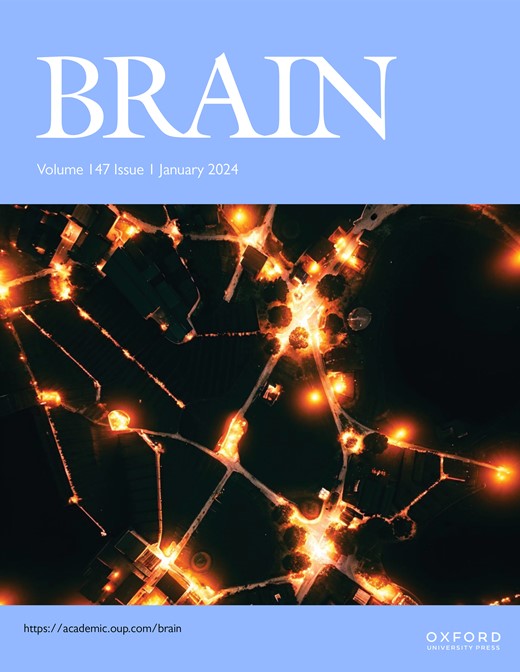中年前橄榄球运动员神经退化的生物标志物证据
IF 11.7
1区 医学
Q1 CLINICAL NEUROLOGY
引用次数: 0
摘要
在橄榄球联盟等接触性运动中,反复的头部撞击和创伤性脑损伤与阿尔茨海默病和慢性创伤性脑病等神经退行性疾病的风险增加有关。流体和成像生物标志物的进步正在改变痴呆症的诊断,但尚未系统地应用于以前在橄榄球比赛中暴露于头部撞击的个人。我们使用生物标志物,包括那些对早期阿尔茨海默病病理学具有敏感性和特异性的生物标志物,来探索具有显著重复性头部撞击暴露的中年精英退役橄榄球运动员的神经退行性风险。采用超灵敏单分子阵列数字酶联免疫吸附法(SiMoA)对前橄榄球精英运动员和年龄/性别匹配的未暴露对照组的血浆神经丝光、胶质原纤维酸蛋白、淀粉样蛋白-β (Aβ)42、Aβ40和磷酸化-陶217进行定量分析。进行了T MRI和神经心理学评估,使用国家神经疾病和中风研究所的标准来确定是否存在创伤性脑病综合征。使用回归模型将血浆/成像生物标志物与临床表型联系起来。基于对照生物标志物分布,对流体和成像指标进行个体水平分析。来自两个对齐的未暴露阿尔茨海默氏症队列的生物标志物数据被纳入我们的研究结果。对200名前橄榄球运动员(中位年龄44岁,90%为男性)和33名未暴露的对照组进行了评估。24名(12%)前球员符合创伤性脑病综合征的标准,但没有人患有痴呆症。前橄榄球运动员血浆磷酸陶217浓度比对照组高17.6%(95%置信区间3.7 ~ 33.3,P = 0.047)。46名退役运动员(23.1%)个体水平有磷酸化-陶217升高;18名(9.0%)玩家认为等离子体神经丝光升高。前球员的浓度低于未接触晚发性阿尔茨海默病的成年人(n = 69)。在基于体素的形态测量中,前球员在组水平上也显示出额叶/扣带皮层的体积显著减少;在退役球员中,白质和海马体积的减少与职业生涯持续时间的延长有关。用弥散张量成像测量的创伤相关白质改变在退役球员中并不常见(4.6%)。创伤性脑病综合征在磷酸化tau217升高的前球员中更为常见,而血浆神经丝光升高的前球员则有更多的焦虑和抑郁症状。额叶脑体积与神经丝光呈负相关(r = - 0.21, P = 0.010),海马体积与phospho-tau217呈负相关(r = - 0.19, P = 0.024)。精英橄榄球参与与中年异常液体和神经成像神经变性生物标志物有关。其中包括磷酸化tau217的升高,这可能表明淀粉样蛋白依赖性tau病理。该结果为使用最先进的神经退行性生物标志物来评估运动头部撞击暴露的长期影响提供了支持。本文章由计算机程序翻译,如有差异,请以英文原文为准。
Biomarker evidence of neurodegeneration in mid-life former rugby players
Repetitive head impacts and traumatic brain injuries in contact sports, such as rugby union, are associated with increased risk of neurodegenerative diseases such as Alzheimer's disease and chronic traumatic encephalopathy. Advances in fluid and imaging biomarkers are transforming dementia diagnosis but have not been systematically applied to individuals previously exposed to head impacts during rugby participation. We used biomarkers, including those with sensitivity and specificity for early Alzheimer's pathology to explore neurodegenerative risk in mid-life elite retired rugby players with significant repetitive head impact exposure. Plasma neurofilament light, glial fibrillary acid protein, amyloid-β (Aβ)42, Aβ40 and phospho-tau217 were quantified using ultrasensitive single molecule array digital enzyme-linked immunosorbent assay (SiMoA) in former elite rugby players as well as age/sex-matched unexposed controls. 3 T MRI and neuropsychology assessments were performed, with National Institute for Neurological Disorders and Stroke criteria used to ascertain the presence of traumatic encephalopathy syndrome. Regression models were used to relate plasma/imaging biomarkers to clinical phenotype. Individual-levels analyses were performed for fluid and imaging metrics, based on control biomarker distributions. Biomarker data from two aligned un-exposed Alzheimer's cohorts were included to contextualize our findings. Two hundred ex-rugby players (median age 44 years, 90% males) and 33 unexposed controls were assessed. Twenty-four (12%) ex-players fulfilled criteria for traumatic encephalopathy syndrome but none had dementia. Plasma phospho-tau217 concentrations were 17.6% higher in ex-rugby players than controls (95% confidence interval 3.7–33.3, P = 0.047). A total of 46 (23.1%) ex-players had elevated phospho-tau217 at the individual level; as did 18 (9.0%) players in relation to raised plasma neurofilament light. Ex-players’ concentrations were lower than in unexposed adults with late onset Alzheimer's disease (n = 69). Ex-players also showed significantly reduced volumes in the frontal/cingulate cortex on voxel-based morphometry at the group level; with reduced white matter and lower hippocampal volume associated with longer career durations within ex-players. Trauma-associated white matter changes measured with diffusion tensor imaging were uncommon in ex-players (4.6%). Traumatic encephalopathy syndrome was significantly more common in ex-players with elevated phospho-tau217, while those with raised plasma neurofilament light had significantly more anxiety and depressive symptoms. Frontal brain volumes correlated negatively with neurofilament light (r = −0.21, P = 0.010), and hippocampal volumes correlated negatively with phospho-tau217 (r = −0.19, P = 0.024). Elite rugby participation is associated with abnormal fluid and neuroimaging neurodegeneration biomarkers in mid-life. These include elevated phospho-tau217, which may indicate amyloid-dependent tau pathology. The results provide support for using state-of-the-art neurodegenerative biomarkers in the evaluation of long-term effects of sports head impact exposure.
求助全文
通过发布文献求助,成功后即可免费获取论文全文。
去求助
来源期刊

Brain
医学-临床神经学
CiteScore
20.30
自引率
4.10%
发文量
458
审稿时长
3-6 weeks
期刊介绍:
Brain, a journal focused on clinical neurology and translational neuroscience, has been publishing landmark papers since 1878. The journal aims to expand its scope by including studies that shed light on disease mechanisms and conducting innovative clinical trials for brain disorders. With a wide range of topics covered, the Editorial Board represents the international readership and diverse coverage of the journal. Accepted articles are promptly posted online, typically within a few weeks of acceptance. As of 2022, Brain holds an impressive impact factor of 14.5, according to the Journal Citation Reports.
 求助内容:
求助内容: 应助结果提醒方式:
应助结果提醒方式:


